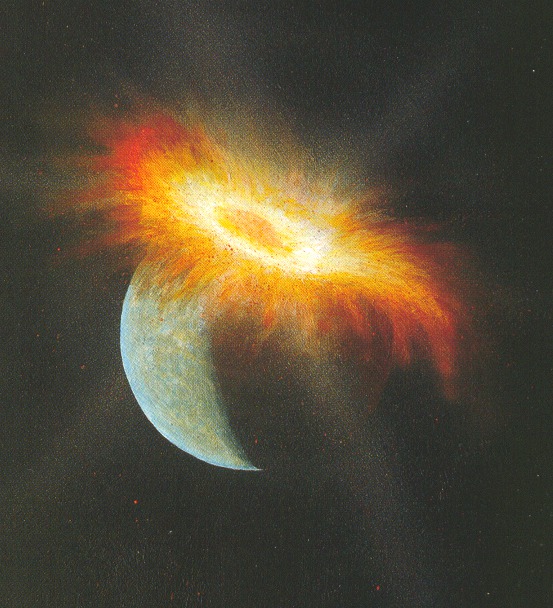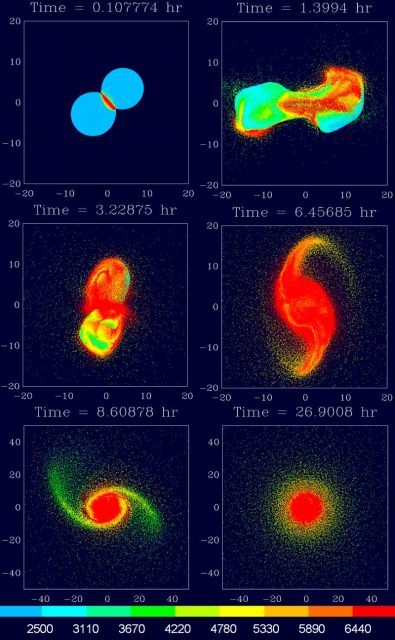The origin of the Moon
Our satellite is a magnificent spectacle in the sky. Considering its size, it is only surpassed by the biggest moons of Jupiter and Saturn, in spite of the fact that the giant planets are hundreds of times bigger than the Earth. Relative to its parent body, it is by large the largest satellite in the whole Solar System, with the only exception of the almost binary system Pluto and Charon. It has even been suggested that its large size supports the habitability of our planet, via the increased inertia of the Earth-Moon system, which in turn provides stability to our rotation axis. From tides to poetry, the influence of Luna is enormous in our life but, somewhat surprisingly, we are not quite sure yet on how this beautiful rock was created or where it comes from. Two recent publications throw new clues on these issues and open an exciting new time for lunar investigations.

A number of hypothesis has been formulated to explain its origin. I obviously speak of scientific explanations, but the topic has been covered by other, let’s say, more doubtful ways of knowledge as well. Let’s focus in what is usually called the giant impact hypothesis formulated in detail for the first time in 1975 by William Hartman and Donal Davis 1. Contrarily to other satellites (those of the gas giants are good examples), the Moon does not look like a captured body. The amount of bodies up to 3,000 km in size in the primordial Solar System made it quite likely that a big one crashed with the young Earth, ejecting the iron-poor Earth crust and forming the Moon from the combination of the impactor and our planet itself.
The idea was promising but some modeling was lacking. Many teams worked hard on this, and they still do. With the increase of the computation power, it was possible to reproduce the interaction of n-bodies to represent the collision of the Earth with a big guy out there. Robin Canup and Erik Asphaug demonstrated in 2001 2 that, in order to reproduce the angular momentum of the present Earth-Moon system and the overall low iron content of the satellite, an intermediate impactor could make the job. Roughly a wandering Mars-like object, sometimes nicknamed Theia, was able to reproduce much of the current observations. Even though our models improved with time (Ref. 3) there was still a question to be answered. Most models showed that there should be more of Theia in the Moon than in the Earth and thus, a small difference in isotopic composition should be detected. But no one had been able to find it, until this year.

The recent work by Daniel Herwartz and collaborators3 is in fact the missing piece of the puzzle. Using samples returned by the Apollo mission, they were able to detect a tiny difference in the triple oxygen isotope between Earth and Moon rocks. This was possible only thanks to a refined and careful analysis technique but it has provided substantial information on the nature of Theia. It can be said with no doubt that the constraints on the current compositional difference is enough to support the giant impact hypothesis: a Mars sized impactor with a chondrite-like composition would be enough to produce the Moon and the Earth as we know them. Herwartz et al. even speculate on the exact type of chondrite required, enstatite or carbonaceous chondrite.

This is not the end of our lunar exciting news for today. An even more recent paper 4, still in press from Astrophysical Journal Letters (though avaible in astro-ph) reveals a possible explanation for the lack of maria in the lunar farside. This was a discovery of the early space exploration but no satisfactory explanation had been provided yet. In the paper by Arpita Roy and collaborators, they propose that the Earthshine, i.e. the heat emitted by the still hot Earth, was enough to support the differences in the crustal thickness in the near- and far-side of our satellite. This is so because the Moon reached the synchronous rotation much faster than any of the two bodies solidified. Even though this theory is still on its first stages, it looks like a promising idea to be tested against new and more detailed numerical models as well as against any other hemispherical differences that can be detected in lunar rocks.
So now, look up there. There it is, shining, one of the biggest satellites in the known Universe. It is the result of cataclismic collision that reformed the Earth as a whole. Both the proto-Earth and Theia were mixed to became the Earth and Moon as we know it. Our planet, hot as hell, left an imprint on the rapidly cooling satellite. We were born together and we are bound for the centuries to come. What new surprises is the science going to provide in that time? Nobody knows yet, and that’s the funniest part.
References
- W.K Hartmann and D.R. Davis (1975). Satellite-sized planetesimals and lunar origin. Icarus 24, 504-515. doi: 10.1016/0019-1035(75)90070-6 ↩
- R.M. Canup and E. Asphaug (2001). Origin of the Moon in a giant impact near the end of Earth’s formation. Nature 412, 708 – 712. doi: 10.1038/35089010 ↩
- Herwartz D., B. Friedrichs & A. Bischoff (2014). Identification of the giant impactor Theia in lunar rocks, Science, 344 (6188) 1146-1150. DOI: http://dx.doi.org/10.1126/science.1251117 ↩
- A. Roy et al. (2014). Earthshine on a young Moon: explaining the lunar farside highlands. Accepted in Astrophysical Journal Letters. arxiv: 1406.2020 ↩
4 comments
[…] Pérez-Hoyosek honen inguruan ideia berriak plazaratzen dituzten bi argitalpen aztertzen ditu The origin of the Moon […]
[…] Desde las mareas a la poesía la Luna ejerce una enorme influencia en la vida en la Tierra. Y, sin embargo, aún no estamos muy seguros de cómo se formó. Santiago Pérez Hoyos analiza dos publicaciones recientes con nuevas […]
[…] [Leer la entrada completa en Mapping Ignorance] […]
Simplifying the whole episode a great deal, speculate that there was no direct contact. No impact.
The two bodies came within their respective Roche Limit and came apart exactly as your model depicts. Most of both bodies were scattered into space. The earth and moon formed up from what was left in the immediate area. Energy was conserved when some immense quantities of rock were “gravity slingshotted” at random parts of the Cosmos. Enough energy was lost in some so that it could orbit.
Space is large. Even with gravity pulling, near-misses are more likely than what Velikovsky called “lithosphere to lithosphere” collisions.. (However, he was wrong about nearly everything else.)